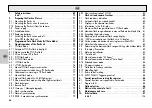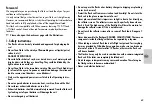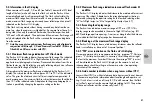
79
ķ
4.8.2 Close-ups / Macrophotography
The flash reflector can be swivelled down by an angle of -7° to compensate
for parallax error. For this purpose depress the unlocking button of the re-
flector and fold down the reflector.
For close-ups it is necessary to ensure that certain minimum lighting distances
are maintained to avoid overexposure.
The minimum lighting distance is approx. 10 per cent of the maximum
flash range indicated on the LC display. Since the maximum flash
range is not indicated on the LC display when the reflector is swivelled
down, then be guided by the maximum flash range indicated by the
flash unit when the reflector is in its normal position!
4.9 Flash synchronisation
4.9.1 Normal synchronisation (Fig. 7)
In normal synchronisation the flash unit is triggered at the beginning of the
exposure time (1st curtain synchronisation). Normal synchronisation is the
standard mode on all cameras, and is suitable for most flash shots. Depend-
ing upon the given mode, the camera is changed over to flash sync speed,
the customary one being between 1/30th sec. and 1/125th sec. (see the
camera’s operating instructions). No settings have to be made on the flash
unit, nor is there any display for this mode.
4.9.2 REAR - Second-curtain synchronisation (Fig. 8)
Some cameras offer the facility of second-curtain synchronisation (REAR
mode) triggering the flash unit by the end of the exposure time. Second-cur-
tain synchronisation is particularly advantageous when using slow shutter
speeds (slower than 1/30 sec.) or when shooting moving objects that have
their own source of light. Second-curtain synchronisation gives a more real-
istic impression of movement because the light streaks behind the light source
instead of building up in front of it, as is the case when the flash is synchro-
nised with the 1st shutter curtain! Depending on its operating mode, the
camera uses shutter speeds slower than its sync speed.
☞
On some cameras the REAR function is not possible in certain operating
modes (e.g. specific Vari or Scene modes or Red Eye Reduction, see 5.9). In
such an instance, the REAR mode cannot be selected or the REAR function is
automatically cancelled or ignored. Please refer to the operating instructions
for the given camera.
Depending on the type of camera used, second curtain synchronisa-
tion (REAR) must either be set on the camera (cameras of Group A, C,
D and E; see Table 1; + Pronea 600i) or on the flash unit (Group B
cameras). Please refer to the information given in the corresonding
camera manual.
The REAR mode is indicated on the flash unit only if the setting was
made on the flash unit.
Activating the REAR mode on the flash unit in conjunction with Group B cameras
• Mount the flash unit on the camera.
• Switch on the flash unit and the camera.
• Lightly touch the camera’s shutter release to induce a data exchange be-
tween the flash unit and the camera.
• Continue depressing the “Select” key combination (= “Mode” key + “Zoom”
key) until “REAR” appears on the LC display.
• Continue depressing the “Zoom” key until “On” flashes on the LC display.
• The setting becomes immediately effective. The LC display returns to its nor-
mal state after approx. 5 sec.
The “REAR” symbol for 2nd curtain synchronisation continues to be indicated
on the flash unit’s LC display after it has been set!
Always use a tripod to avoid camera shake with slow shutter speeds!
Do not forget to switch off this function after exposure, otherwise un-
intended slow shutter speeds will continue to be used for “normal”
flash shots.
☞
☞
Содержание MECABLITZ 54 AF-1 N
Страница 45: ...45 ĸ ...
Страница 67: ...67 ń ...
Страница 89: ...89 ķ ...
Страница 111: ...111 ƴ ...
Страница 138: ...138 Bild 5 Fig 5 Afb 5 Grab 5 Bild 6 Fig 6 Afb 6 Grab 6 Bild 7 Fig 7 Afb 7 Grab 7 Bild 8 Fig 8 Afb 8 Grab 8 ...
Страница 141: ...141 ...
















































